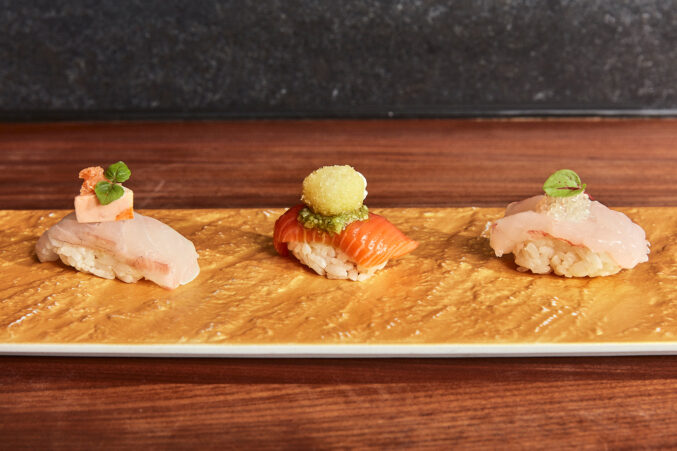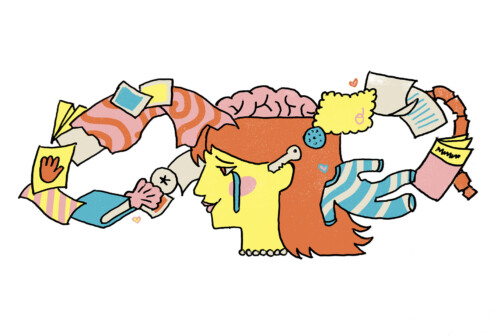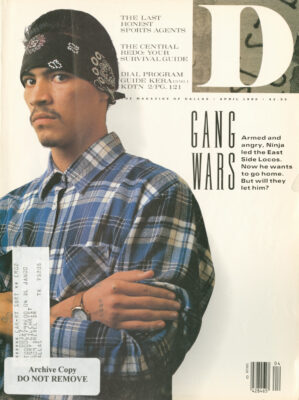Convinced that the proper objects for home design are those with a sentiment or idea attached to them, and not just things that are stylistically “correct,” we’re taking a second look at things we already have. Andy Warhol raised our collection consciousness when, in addition to the obvious modern art, his collection of cookie jars brought such high prices on the auction block. Now a lot of Dallasites are getting the courage to bring their own collections-however odd or esoteric-out of the closet and into the living room.
The first thing you notice in artist Pam Nelson’s dining room is not the art, but her incredible, non-edible collection of fake food. It takes the place of dishes in the glass-fronted china cabinet, serves as a centerpiece on the table, and ornaments the sideboard. In SaJly Griffiths’s proper Highland Park home, a collection of oddball neckties, studded with her collection of Oddfellow pins, hangs from the bathroom towel racks. In the den, showcases of robots, spaceships, and atomic monsters serve as a room divider. Graphic designer Rex Peteet’s home is hung with a circus-worth of masks, and the shadow box shelves in Britt Brown’s kitchen were built to display his carefully collected salt and pepper shakers.
There are all kinds of collectors: the compulsive pack rats who collect everything; the binge-purgers who acquire avidly up to a point, then rid themselves of everything and start all over; and the investment collectors with an intellectual approach to acquisition. But most collectors aren’t motivated by anything so simple as financial acumen. They’re captivated by an image or object, like falling in love. An editor at this magazine inexplicably collects doorknobs, an illustrator searches shops and flea markets for snow globes, a friend can’t resist frogs. The outsider’s question of lovers, “what could he possibly see in her?” has its match here.
“I collect because I have to,” Britt Brown attempts to explain. “I’ve always collected-I have some sort of interest in defining something, culture collecting.” Like many collectors, Brown has definite personal rules: “Lots of people collect salt and pepper shakers; some actually have thousands. That doesn’t interest me. I’m only interested in plastic sets from the Fifties.” Brown’s eye-catching collection becomes abstract when viewed together-the colors are so bright and hard and the shapes so unlikely as to be surreal. Two top hats on a hat rack turn out to be a pair of shakers. Two plastic salt and pepper parrots perch on a vivid green branch. There’s a tabletop croquet set in a caddy complete with different colored balls; each mallet has holes in the head for the seasonings. “I like the texture of the plastic,” muses Brown. “And the harsh colors. And I especially like home how mass-produced these are- they’re cheap items and have always been overlooked. They’re really uncollected- people tend to throw them away. So their valuelessness makes them rare.”
The repetition of objects that are the same-only different-is part of why Rex Peteet, co-owner of Sibley-Peteet Design, is fascinated with masks. He found his first, he recalls, in a junk pile. Now his collection includes sophisticated African pieces, subtle Indonesian faces, and extravagantly exaggerated Mexican heads; they were purchased everywhere from Boston to Acapulco.
“Masks have a universal appeal-they’re like a distorted mirror image of the human face and each one is as individual,” says Peteet. “There are really no two alike, even when they represent the same thing. None of them are very valuable intrinsically. Their value comes from my enthusiasm for them.”
There’s a collection in every cranny of Sally Griffiths’s house: hats hung on the wall of the stairwell, “pope dope” (souvenirs of the pontiffs San Antonio visit) in the breakfast room. “If I find I have more than five of something,” she says, “it’s a collection, and I start to seek it out.” Griffiths’s collection started with a fascination for her children’s toys; now her largest collection, wind-ups and space toys, crams the glass cases in her den and fills shelves intended for books.
Pam Nelson’s art is concerned with assemblage. As she explains, “I put things together that haven’t been put together before.” The results: winged tables with seashell-studded legs, a mirror framed with jewels and credit cards, tin-can roses replacing the face on a clock. “I’m recategorizing things in my art. Looking at them in a new way. And that’s a lot of what collecting is about Tor me,” Nelson says.
The food collection started when Nelson found fruit made by WPA artists for use in nutrition instruction. Now the pieces range from professionally made resin representations of sushi to the molded plaster Tex-Mex combination plate her children made.
Though Nelson has a distinct preference for pieces made by hand, such as the brilliant bowl of sequined fruit her grandmother created, she is no purist. There’s a set of coasters made in the shape of luncheon-meat slices alongside the soulful stuff because “it’s not just visual pleasure I get from it. It’s the idea. It was someone’s quirky idea, and I’m rescuing that spirit”
Get our weekly recap
Brings new meaning to the phrase Sunday Funday. No spam, ever.
Related Articles

Local News
Bill Hutchinson Pleads Guilty to Misdemeanor Sex Crime
The Dallas real estate fun-guy will serve time under home confinement and have to register as a sex offender.
By Tim Rogers

Restaurants & Bars
The Best Japanese Restaurants in Dallas
The quality and availability of Japanese cuisine in Dallas-Fort Worth has come a long way since the 1990s.
By Nataly Keomoungkhoun and Brian Reinhart

Home & Garden
One Editor’s Musings on Love and Letting Go (Of Stuff, That Is)
Memories are fickle. Stuff is forever. Space is limited.
By Jessica Otte


